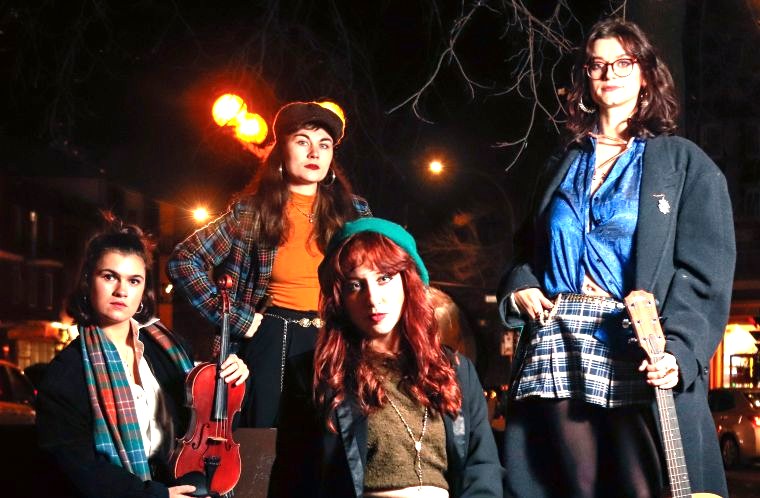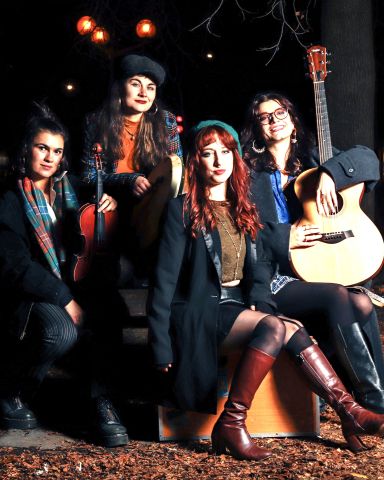
Within Montreal’s Irish cultural scene, one band is redefining what it means to carry tradition forward. Gráinne, an evocative all-female folk group composed of Darragh Mondoux, Esme Cavanagh, Lily MacLean, and recent addition Ella Partington, isn’t just a band; they are a feminine force shaping the future of folk music.
Rooted in a shared passion for Irish folklore and resistance ballads, the women of Gráinne represent a tapestry of cultural backgrounds. Drawing from Irish-Canadian, Trinidadian-Dutch, Venezuelan, and Scottish roots, each member brings depth and diversity to the group’s sound and purpose. As Mondoux puts it, “We all identify as Irish culturally, wrestling with what it means to be ‘Canadian’, and the various ethnicities that go with it.”
The group’s journey began humbly in 2022 at Concordia University’s Irish Studies program. Originally meant to be a one-time performance for a Bealtaine Ball, the musical experiment soon blossomed into something more enduring. “It became a summer of harmonizing and arranging, reinterpreting and rehearsing,” recalls Mondoux. “Three years later, we’re still proud of our place in the Irish Montreal and folk music communities.”
In time, Gráinne would evolve from music into something more meaningful. “The folk songs we play are imbued with resistance, romance, rebellion, and revelry,” Mondoux explains. “We’re very drawn to rebel songs and historical narratives. That’s where some of our ‘Canadiana’ folk fall into our repertoire. Old work songs like ‘Wellerman’ that exploded during lockdowns inspired us deeply.”
For Partington, who recently immigrated from Galway, Ireland, joining Gráinne was a revelation. “The Irish music scene back home is very male-dominated,” she reflects. “Playing here with women my age lets me reimagine songs like ‘Whiskey in the Jar’ through the different perspectives that women can bring to songs like these.”
MacLean echoes this sentiment with poetic clarity: “It’s a fulfillment of my cultural legacy, but also of a childhood fantasy of being a culturally-informed, musical woman. I remember walking along Ste. Catherine Street and seeing a woman playing ‘Star of the County Down’ on a harp. I was dazzled. There seems to be a surge of all-women Celtic bands popping up all over the world.”

Their recent debut EP, Óró Sé Do Bheatha Bhaile, is tied to Gráinne O’Malley, the pirate queen and namesake of the band. “It’s a song about exile, rebellion, and femininity,” MacLean explains. Recorded “live off the floor,” the EP captures the raw energy of their pub gigs and community performances.
Beyond the music itself, Gráinne shines through their theatrical storytelling. In 2024, they staged Thinning the Veil: An Irish Halloween Experience, an hour-long showcase of musical lore. “An Irish legacy of Halloween was always inevitable,” says Mondoux. MacLean adds, “My master’s thesis was on the sean-nós tradition, which is all about storytelling.
“Though men often dominate recordings, women, mothers, and grandmothers carried-on the oral tradition. It is very powerful to bring that forward on the stage and in the studio.”
The power of that cultural reclamation reached a peak when the group sang an ancient song of death in Irish during the Thinning of the Veil performance. “There was stillness, with grown men crying,” MacLean recalls. “But the best part was that we were being diligently supported by three male musicians who believed in our vision.”
Still, not every venue embraces their blend of shanties and rebel songs. “We have to read the room,” Mondoux admits. “Friends of Sinn Féin are all in, but Bloomsday Montreal had to be coaxed into letting us perform a Pogues tune.”
Yet, just like the tradition itself, their audiences are evolving. “Trad is cool again,” says Partington. “Post-COVID, people dusted off the tin whistle and remembered where they came from. But that identity is changing, especially for women. All-women groups like Biird are breaking from the airy-fairy and delicate representations of Irish femininity.”
Gráinne brings their rawness to the stage with intention. “A good live show is visual as well as sonic,” Cavanaugh insists. “We coordinate outfits. We have chemistry. We’re friends, and we can share that with any room.”
For Mondoux, the stories behind the music matter just as much as the songs themselves. “History is the story that keeps going,” she says. “Irish ballads of romance are also expressions of colonization, emigration, and resistance.”
For now, Gráinne stands at a crossroads that bridges ancient melodies with modern conviction. “In the sean-nós tradition, there is an aspect of ‘saying’ the songs, called the scéal, which means ‘the story’,” adds Mondoux. “These songs are about expressing a feeling so that the listener can feel it too.”
@grainnemtl














Leave a Comment